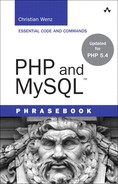0%
20Chapters
0-1Hours read
0kTotal Words
Book Description
PHP and MySQL Phrasebook gives you the code you need to complete your web programming projects quickly and effectively in PHP, the leading scripting language for creating dynamic web pages.
Concise and Accessible
Easy to carry and easy to use–lets you ditch all those bulky books for one portable pocket guide
Flexible and Functional
Packed with more than 100 customizable code snippets–so you can readily code functional PHP and MySQL in just about any situation
Table of Contents
- Title Page
- Copyright Page
- Table of Contents
- About the Author
- We Want to Hear from You!
- Reader Services
- Introduction
- 1. Manipulating Strings
- Comparing Strings
- Checking Usernames and Passwords
- Converting Strings into HTML
- Using Line Breaks
- Encrypting Strings
- Checksumming Strings
- Extracting Substrings
- Protecting Email Addresses Using ASCII Codes
- Scanning Formatted Strings
- Getting Detailed Information about Variables
- Searching in Strings
- Using Perl-Compatible Regular Expressions
- Finding Tags with Regular Expressions
- Validating Mandatory Input
- Validating Email Addresses
- Search and Replace
- 2. Working with Arrays
- Accessing All Elements of Numeric Arrays
- Accessing All Elements of Associative Arrays
- Accessing All Array Elements in Nested Arrays
- Turning an Array into Variables
- Converting Strings to Arrays
- Converting Arrays to Strings
- Sorting Arrays Alphabetically
- Sorting Associative Arrays Alphabetically
- Sorting Nested Arrays
- Sorting Nested Associative Arrays
- Sorting IP Addresses (as a Human Would)
- Sorting Anything
- Sorting with Foreign Languages
- Applying an Effect to All Array Elements
- Filtering Arrays
- Getting Random Elements Out of Arrays
- Making Objects Behave Like Arrays
- 3. Date and Time
- Using Text within date()
- Formatting DateTime Objects
- Automatically Localizing Dates
- Manually Localizing Dates
- Using the Current Date, the U.S./U.K./European Way
- Formatting a Specific Date
- Validating a Date
- Calculating a Relative Date
- Creating a Sortable Time Stamp
- Converting a String into a Date
- Determining Sunrise and Sunset
- Using Date and Time for Benchmarks
- Using Form Fields for Date Selection
- Create Self-Updating Form Fields for Date Selection
- Calculating the Difference between Two Dates
- Using GMT Date/Time Information
- 4. Working with Objects (and Related Topics)
- 5. Interacting with Web Forms
- Sending Form Data Back to the Current Script
- Reading Out Form Data
- Checking Whether a Form Has Been Submitted
- Saving Form Data into a Cookie
- Prefilling Text Fields and Password Fields
- Prefilling Multiline Text Fields
- Preselecting Radio Buttons
- Preselecting Check Boxes
- Preselecting Selection Lists
- Preselecting Multiple Selection Lists
- Processing Graphical Submit Buttons
- Checking Mandatory Fields
- Checking Selection Lists
- Escaping Output
- Validating Input
- Writing All Form Data into a File
- Sending All Form Data via Email
- Getting Information about File Uploads
- Moving Uploaded Files to a Safe Location
- Monitoring the Progress of a File Upload
- 6. Remembering Users (Cookies and Sessions)
- Understanding Cookies
- Creating a Cookie
- Reading Out Cookies
- Setting a (Reasonable) Expiry Date
- Setting a Client-Specific Expiry Date
- Deleting a Cookie
- Making Cookies Accessible for Several Domains
- Checking Whether the Client Supports Cookies
- Saving Multiple Data in One Cookie
- Saving the User’s Language Preference
- Understanding Sessions
- Where to Store the Sessions
- How to Maintain the Session State
- Activating Sessions
- Reading and Writing Sessions
- Closing Sessions
- Changing the Session ID
- Implementing a Custom Session Management
- Creating a Secured Area with Sessions
- Creating a Secured Area without Sessions
- 7. Using Files on the Server File System
- Opening and Closing Files
- Reading from Files
- Writing to Files
- Locking Files
- Using Relative Paths for File Access
- Avoiding Security Traps with File Access
- Working with CSV Data
- Parsing INI Files
- Retrieving File Information
- Copying, Moving, and Deleting Files
- Browsing the File System
- Using PHP Streams
- Using Bzip2 Archives
- Returning Files with an HTTP Request
- 8. Working with MySQL Databases
- 9. Working with Other Databases
- Connecting to SQLite
- Sending SQL to SQLite
- Retrieving Results of a Query to SQLite
- Using Prepared Statements with SQLite
- Connecting to PostgreSQL
- Sending SQL to PostgreSQL
- Updating Data in PostgreSQL
- Retrieving Results of a Query to PostgreSQL
- Connecting to Oracle
- Sending SQL to Oracle
- Retrieving Results of a Query to Oracle
- Connecting to MSSQL
- Sending SQL to MSSQL
- Retrieving Results of a Query to MSSQL
- Using Prepared Statements with MSSQL
- Using MSSQL without Windows
- Connecting to Firebird
- Sending SQL to Firebird
- Retrieving Results of a Query to Firebird
- Connecting via PDO
- Sending SQL via PDO
- Retrieving Results of a Query via PDO
- 10. Using XML
- 11. Communicating with Others
- Connecting with HTTP Servers
- Connecting with FTP Servers
- Checking Whether a Server Is Still Reacting
- Creating a Web Service with NuSOAP
- Automatically Generating WSDL with NuSOAP
- Consuming a Web Service with NuSOAP
- Creating a Web Service with the PHP 5 SOAP Extension
- Consuming a Web Service with the PHP 5 SOAP Extension
- Using Ajax
- Exchanging Data with the Server
- Index
